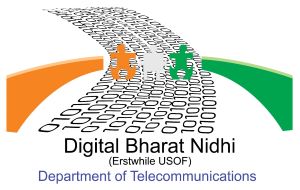Chairman DCC & Secretary (T)
Shri K. Rajaraman, IAS
Chairman DCC & Secretary Telecom,
2nd Floor, Sanchar Bhawan, 20, Ashoka Road,
New Delhi. PIN- 110001
In an increasingly interconnected world, India is engaging international attention due to its progress and potential as a leading participant. The size of the digital economy in India is in fact expected to cross the USD 1 trillion mark from the current estimated level of around USD 350 billion. Telecommunications is expected to play a pivotal role in this extraordinary growth trajectory, contributing more than 50% to the Digital Economy.
For the Indian economy to realise the full benefits of this boom, we need a robust and ubiquitous telecommunications infrastructure and services ecosystem so that the payoff of the digital economy is not only maximised, but also permeates across regions and to all segments of the population. A recent (June 2017) ICRIER study reveals that a 10% increase in internet usage in India can lead to a 3.3% increase in our GDP. This is primarily because the internet overcomes the lack of other physical infrastructure and can enable access to basic services such as education and health.
The telecom sector in India is poised to provide a solid foundation for sustained and equitable growth. Voice has become almost free in India and data is among the cheapest in the world. Devices too are becoming increasingly affordable. Thus today, a feature phone can be purchased for Rs 250 (less than USD 4) and there are smartphones that are available for Rs 1,500 (less than USD 24). The mobile phone is in fact emerging as the most important instrument enabling universal access to a variety of services and 40% of the internet economy is being contributed by mobiles. The growth rate of data in India, in recent times, has been about 500% which is not only the fastest but is making India the biggest consumer of mobile data in the world, ahead of US and China.
In order for the telecommunications sector to scale up to meet the expectations of all stakeholders including citizens, the industry, and the Government, an investment of around USD 60 billion is required to be made over the next two years. This is going to be a challenge considering that the total investment in the sector over the last couple of decades has been of the order of around USD 140 billion. The creation of a conducive business environment is thus critical to catalyse the needed level of investment.
The Department of Telecommunications is striving to play the role of an enabler for the growth of the telecommunications sector and thereby, the that of the digital economy. The National Telecom Policy 2018, currently being formulated by DoT, shall strive to take a holistic view of the various factors that would enable the robust and dynamic growth of the sector in the long run. The key themes that the NTP is aiming to look at include, the regulatory & licensing framework impacting the sector, connectivity for all, quality of services (QoS), ease of doing business and absorption of new technologies including 5G and the Internet of Things (IoT). The common underlying themes of ‘Make in India’ and ‘Skill India,’ would of course, cut across all of the above. The guiding principle of the NTP would be to align with the larger national vision while taking on board the views of all stakeholders.
The Department also continues to work towards the critical objective of universal mobile and broadband connectivity. The BharatNet project, which aims to create high-speed broadband infrastructure catering to almost the entire rural population, continues to be the focus of this endeavour. Various other USOF programs, including those aimed at connectivity for the North East and Left Wing Extremism, impacted areas, are also enabling mobile connectivity in hitherto uncovered areas.
We are indeed today at an extremely exciting phase of the Indian telecommunications revolution. It is imperative that we aim for a technology-led transformation by fully harnessing the tremendous power of telecommunications in order to leapfrog towards a brighter future. I am sure that with the present renewed focus on strengthening and modernising our telecommunications sector, we would soon be able to achieve our objective of wide spread and equitable growth.








